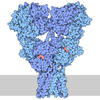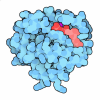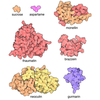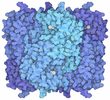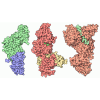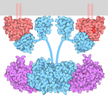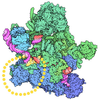+ データを開く
データを開く
- 基本情報
基本情報
| 登録情報 | データベース: PDB / ID: 8.0E+96 | |||||||||
|---|---|---|---|---|---|---|---|---|---|---|
| タイトル | Glycine and glutamate bound Human GluN1a-GluN2D NMDA receptor | |||||||||
 要素 要素 |
| |||||||||
 キーワード キーワード | TRANSPORT PROTEIN / Ligand-gated ion channel / ionotropic glutamate receptor / synaptic protein / voltage-gate ion channel | |||||||||
| 機能・相同性 |  機能・相同性情報 機能・相同性情報glycine-gated cation channel activity / regulation of sensory perception of pain / excitatory chemical synaptic transmission / Synaptic adhesion-like molecules / cellular response to L-glutamate / response to glycine / propylene metabolic process / regulation of monoatomic cation transmembrane transport / Assembly and cell surface presentation of NMDA receptors / NMDA glutamate receptor activity ...glycine-gated cation channel activity / regulation of sensory perception of pain / excitatory chemical synaptic transmission / Synaptic adhesion-like molecules / cellular response to L-glutamate / response to glycine / propylene metabolic process / regulation of monoatomic cation transmembrane transport / Assembly and cell surface presentation of NMDA receptors / NMDA glutamate receptor activity / voltage-gated monoatomic cation channel activity / neurotransmitter receptor complex / NMDA selective glutamate receptor complex / Neurexins and neuroligins / ligand-gated sodium channel activity / glutamate binding / calcium ion transmembrane import into cytosol / protein heterotetramerization / glycine binding / startle response / positive regulation of reactive oxygen species biosynthetic process / monoatomic cation transmembrane transport / Negative regulation of NMDA receptor-mediated neuronal transmission / Unblocking of NMDA receptors, glutamate binding and activation / positive regulation of calcium ion transport into cytosol / Long-term potentiation / monoatomic cation transport / excitatory synapse / positive regulation of excitatory postsynaptic potential / monoatomic ion channel complex / regulation of neuronal synaptic plasticity / synaptic cleft / calcium ion homeostasis / glutamate-gated receptor activity / presynaptic active zone membrane / glutamate-gated calcium ion channel activity / EPHB-mediated forward signaling / ligand-gated monoatomic ion channel activity involved in regulation of presynaptic membrane potential / sodium ion transmembrane transport / ionotropic glutamate receptor signaling pathway / Ras activation upon Ca2+ influx through NMDA receptor / positive regulation of synaptic transmission, glutamatergic / hippocampal mossy fiber to CA3 synapse / adult locomotory behavior / excitatory postsynaptic potential / regulation of membrane potential / synaptic transmission, glutamatergic / transmitter-gated monoatomic ion channel activity involved in regulation of postsynaptic membrane potential / synaptic membrane / postsynaptic density membrane / brain development / visual learning / calcium ion transmembrane transport / regulation of synaptic plasticity / long-term synaptic potentiation / terminal bouton / synaptic vesicle / signaling receptor activity / amyloid-beta binding / RAF/MAP kinase cascade / response to ethanol / chemical synaptic transmission / dendritic spine / postsynaptic membrane / calmodulin binding / neuron projection / postsynaptic density / synapse / dendrite / calcium ion binding / endoplasmic reticulum membrane / protein-containing complex binding / glutamatergic synapse / cell surface / positive regulation of transcription by RNA polymerase II / plasma membrane / cytoplasm 類似検索 - 分子機能 | |||||||||
| 生物種 |  Homo sapiens (ヒト) Homo sapiens (ヒト) | |||||||||
| 手法 | 電子顕微鏡法 / 単粒子再構成法 / クライオ電子顕微鏡法 / 解像度: 3.38 Å | |||||||||
 データ登録者 データ登録者 | Kang, H. / Furukawa, H. | |||||||||
| 資金援助 |  米国, 2件 米国, 2件
| |||||||||
 引用 引用 |  ジャーナル: Mol Cell / 年: 2022 ジャーナル: Mol Cell / 年: 2022タイトル: Structural insights into assembly and function of GluN1-2C, GluN1-2A-2C, and GluN1-2D NMDARs. 著者: Tsung-Han Chou / Hyunook Kang / Noriko Simorowski / Stephen F Traynelis / Hiro Furukawa /  要旨: Neurotransmission mediated by diverse subtypes of N-methyl-D-aspartate receptors (NMDARs) is fundamental for basic brain functions and development as well as neuropsychiatric diseases and disorders. ...Neurotransmission mediated by diverse subtypes of N-methyl-D-aspartate receptors (NMDARs) is fundamental for basic brain functions and development as well as neuropsychiatric diseases and disorders. NMDARs are glycine- and glutamate-gated ion channels that exist as heterotetramers composed of obligatory GluN1 and GluN2(A-D) and/or GluN3(A-B). The GluN2C and GluN2D subunits form ion channels with distinct properties and spatio-temporal expression patterns. Here, we provide the structures of the agonist-bound human GluN1-2C NMDAR in the presence and absence of the GluN2C-selective positive allosteric potentiator (PAM), PYD-106, the agonist-bound GluN1-2A-2C tri-heteromeric NMDAR, and agonist-bound GluN1-2D NMDARs by single-particle electron cryomicroscopy. Our analysis shows unique inter-subunit and domain arrangements of the GluN2C NMDARs, which contribute to functional regulation and formation of the PAM binding pocket and is distinct from GluN2D NMDARs. Our findings here provide the fundamental blueprint to study GluN2C- and GluN2D-containing NMDARs, which are uniquely involved in neuropsychiatric disorders. | |||||||||
| 履歴 |
|
- 構造の表示
構造の表示
| 構造ビューア | 分子:  Molmil Molmil Jmol/JSmol Jmol/JSmol |
|---|
- ダウンロードとリンク
ダウンロードとリンク
- ダウンロード
ダウンロード
| PDBx/mmCIF形式 |  8e96.cif.gz 8e96.cif.gz | 507.1 KB | 表示 |  PDBx/mmCIF形式 PDBx/mmCIF形式 |
|---|---|---|---|---|
| PDB形式 |  pdb8e96.ent.gz pdb8e96.ent.gz | 400.7 KB | 表示 |  PDB形式 PDB形式 |
| PDBx/mmJSON形式 |  8e96.json.gz 8e96.json.gz | ツリー表示 |  PDBx/mmJSON形式 PDBx/mmJSON形式 | |
| その他 |  その他のダウンロード その他のダウンロード |
-検証レポート
| 文書・要旨 |  8e96_validation.pdf.gz 8e96_validation.pdf.gz | 995.1 KB | 表示 |  wwPDB検証レポート wwPDB検証レポート |
|---|---|---|---|---|
| 文書・詳細版 |  8e96_full_validation.pdf.gz 8e96_full_validation.pdf.gz | 1022.6 KB | 表示 | |
| XML形式データ |  8e96_validation.xml.gz 8e96_validation.xml.gz | 76.9 KB | 表示 | |
| CIF形式データ |  8e96_validation.cif.gz 8e96_validation.cif.gz | 115.7 KB | 表示 | |
| アーカイブディレクトリ |  https://data.pdbj.org/pub/pdb/validation_reports/e9/8e96 https://data.pdbj.org/pub/pdb/validation_reports/e9/8e96 ftp://data.pdbj.org/pub/pdb/validation_reports/e9/8e96 ftp://data.pdbj.org/pub/pdb/validation_reports/e9/8e96 | HTTPS FTP |
-関連構造データ
| 関連構造データ |  27957MC  8e92C  8e93C  8e94C  8e97C  8e98C  8e99C M: このデータのモデリングに利用したマップデータ C: 同じ文献を引用 ( |
|---|---|
| 類似構造データ | 類似検索 - 機能・相同性  F&H 検索 F&H 検索 |
- リンク
リンク
- 集合体
集合体
| 登録構造単位 | 
|
|---|---|
| 1 |
|
- 要素
要素
| #1: タンパク質 | 分子量: 93078.250 Da / 分子数: 2 / 変異: C22S, R844N, R845G, K846A / 由来タイプ: 組換発現 / 由来: (組換発現)  Homo sapiens (ヒト) / 遺伝子: GRIN1, NMDAR1 Homo sapiens (ヒト) / 遺伝子: GRIN1, NMDAR1発現宿主:  参照: UniProt: Q05586 #2: タンパク質 | 分子量: 96760.492 Da / 分子数: 2 / 由来タイプ: 組換発現 / 由来: (組換発現)  Homo sapiens (ヒト) / 遺伝子: GRIN2D, GluN2D, NMDAR2D Homo sapiens (ヒト) / 遺伝子: GRIN2D, GluN2D, NMDAR2D発現宿主:  参照: UniProt: O15399 #3: 化合物 | #4: 糖 | ChemComp-NAG / #5: 化合物 | 研究の焦点であるリガンドがあるか | Y | Has protein modification | Y | |
|---|
-実験情報
-実験
| 実験 | 手法: 電子顕微鏡法 |
|---|---|
| EM実験 | 試料の集合状態: PARTICLE / 3次元再構成法: 単粒子再構成法 |
- 試料調製
試料調製
| 構成要素 | 名称: Hetero-tetrameric GluN1a-GluN2D NMDA receptors / タイプ: COMPLEX / Entity ID: #1-#2 / 由来: RECOMBINANT |
|---|---|
| 由来(天然) | 生物種:  Homo sapiens (ヒト) Homo sapiens (ヒト) |
| 由来(組換発現) | 生物種:  |
| 緩衝液 | pH: 7.5 |
| 試料 | 濃度: 4 mg/ml / 包埋: NO / シャドウイング: NO / 染色: NO / 凍結: YES |
| 試料支持 | グリッドの材料: COPPER / グリッドのサイズ: 300 divisions/in. / グリッドのタイプ: Quantifoil R1.2/1.3 |
| 急速凍結 | 装置: FEI VITROBOT MARK IV / 凍結剤: ETHANE / 湿度: 85 % / 凍結前の試料温度: 285 K |
- 電子顕微鏡撮影
電子顕微鏡撮影
| 実験機器 |  モデル: Titan Krios / 画像提供: FEI Company |
|---|---|
| 顕微鏡 | モデル: FEI TITAN KRIOS |
| 電子銃 | 電子線源:  FIELD EMISSION GUN / 加速電圧: 300 kV / 照射モード: FLOOD BEAM FIELD EMISSION GUN / 加速電圧: 300 kV / 照射モード: FLOOD BEAM |
| 電子レンズ | モード: BRIGHT FIELD / 最大 デフォーカス(公称値): 2400 nm / 最小 デフォーカス(公称値): 600 nm |
| 試料ホルダ | 凍結剤: NITROGEN |
| 撮影 | 電子線照射量: 74.7 e/Å2 フィルム・検出器のモデル: GATAN K3 BIOQUANTUM (6k x 4k) |
| 電子光学装置 | エネルギーフィルター名称: GIF Bioquantum / エネルギーフィルタースリット幅: 20 eV |
- 解析
解析
| ソフトウェア | 名称: PHENIX / バージョン: 1.19.2_4158: / 分類: 精密化 | ||||||||||||||||||||||||
|---|---|---|---|---|---|---|---|---|---|---|---|---|---|---|---|---|---|---|---|---|---|---|---|---|---|
| EMソフトウェア |
| ||||||||||||||||||||||||
| CTF補正 | タイプ: PHASE FLIPPING AND AMPLITUDE CORRECTION | ||||||||||||||||||||||||
| 粒子像の選択 | 選択した粒子像数: 8012932 | ||||||||||||||||||||||||
| 対称性 | 点対称性: C1 (非対称) | ||||||||||||||||||||||||
| 3次元再構成 | 解像度: 3.38 Å / 解像度の算出法: FSC 0.143 CUT-OFF / 粒子像の数: 199693 / 対称性のタイプ: POINT | ||||||||||||||||||||||||
| 原子モデル構築 | プロトコル: RIGID BODY FIT | ||||||||||||||||||||||||
| 原子モデル構築 | 3D fitting-ID: 1 / Source name: PDB / タイプ: experimental model
| ||||||||||||||||||||||||
| 拘束条件 |
|
 ムービー
ムービー コントローラー
コントローラー













 PDBj
PDBj